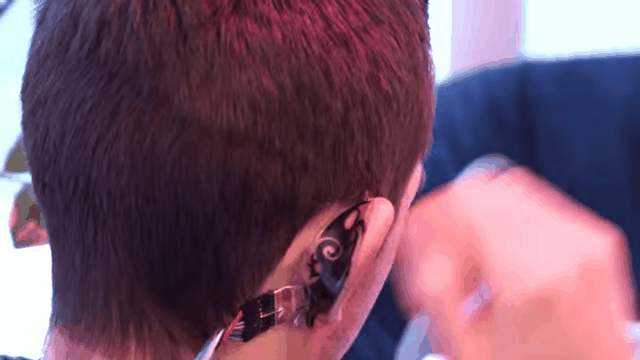Smartwatches, tablets and phones are great, but they’re not exactly futuristic technology. To find that, you have to look to the scientists and designers who are prototyping entirely new kinds of devices.
Last week, dozens of groups from universities around the world gathered at the Association for Computing Machinery’s Computer-Human Interaction Conference in Seoul — also known as CHI.
The term “interaction design” can mean many things, and the dozens of papers presented reflected that. There were alternatives to traditional passwords. There was research about how humans feel about their robot co-workers. And entirely new types of user interfaces that attach to everything from your skin to your fingernails.
These projects aren’t just next year’s technology — they’re next decade’s. Take a look.
Why Humans Like (or Hate) Their Robot Co-Workers
One big focus of papers at CHI is how humans will deal with having robot co-workers. A paper from Tufts looks at how robots who look too human — eg the “uncanny valley” — can have a negative effect on human workers.
On the other hand, robots need some human characteristics. A University of Wisconsin paper studied how factory workers relate to the robotic machines they work alongside, finding that it’s important that robots in the workplace be carefully designed for “sociability”, since human workers attribute good and bad behavioural characteristics to them anyways — and rely on them at work.
Interfaces On Your Fingers and In Your Paper
Need to swipe through a recipe on your laptop while you’re elbow deep in flour? Thankfully, you’re wearing a NailO, a tiny thumbnail interface inspired by nail art. Developed by MIT Media Lab, the project was presented at the conference after the team uploaded a great video of the nail in action:
A project called FluxPaper from Microsoft and Keio University followed the same logic of giving everyday objects new life as interactive devices. FluxPaper is exceedingly simple: It’s paper… But with a thin magnetic coating. Paired with a “programmable” magnetic field, it’s possible to create interactive situations with material as simple as paper.
Can’t imagine what that looks like? Check out some example in their video — including origami tutorials led by a magnetic tutor:
The Passwords of the Future
It’s not news that traditional passwords are dying away , but the verdict is still out on what will replace them. Several papers at CHI presented alternatives, like one from University of Munich subtitled I Know What You Did Last Week! Do You?
The team developed a way to gain access to your smartphone — should you forget the passcode or have some other authentication issue — by asking users basic information about how they used the phone on previous days, including the apps they used and who they called.
Another project called SwiPIN was focused on making traditional PINs more secure — by making it much tougher to see on the screen. Rather than a keypad, users swipe a series of simple gestures, like up and down, which are much harder to spy from afar:
3D Printers That Print Fabric and Respond to Touch
Another cool area of the conference dealt with fabrication. Disney’s research team presented a cool new 3D printer, which can print soft fabric objects.
Then there was a paper that introduced Tactum, a system that lets you model objects directly on your skin by touching it and then print them out, leading the way for everything from personalised fashion to prosthetics.
Notifications Will Be Felt
Sure, tactile notifications like the ones emitted from your phone or watch as vibrations are useful.
But they’re pretty boilerplate, at the moment — usually just a series of buzzes. Researchers from Germany presented an entirely new system for notifying users with tactile feedback. Somewhat terrifyingly, it’s called “Skin Drag,” and it uses a rotating tactor to communicate information with more emphasis than just a buzz. That lets you glean information like shapes from the notification — or even letters, which could definitely be useful. Here it is in action:
On the more bizarre end of the spectrum, there’s a project called Cruise Control for Pedestrians. It looks at how a small electrical stimulator on your leg could be used to act as, well, cruise control while you’re walking. It doesn’t control your muscle movement — it just suggests a pace.
Devices Designed By You
Who wants to wear the same smartwatch as everyone else, even if that everyone else includes Beyonce? A project called Patina Engraver focused on how to make trackers a little cooler — by engraving them with activity data over time so that the band becomes a personalised look at how you move:
A thin and flexible material called iSkin was also on display. The idea is to give people the power to create interfaces directly on their skin with this thin, soft electrode-embedded sticker as the input. You could, for example, put a patch behind your ear to control the volume of your phone. Or curl up a piece near your smartwatch to roll out when you need a keyboard:
